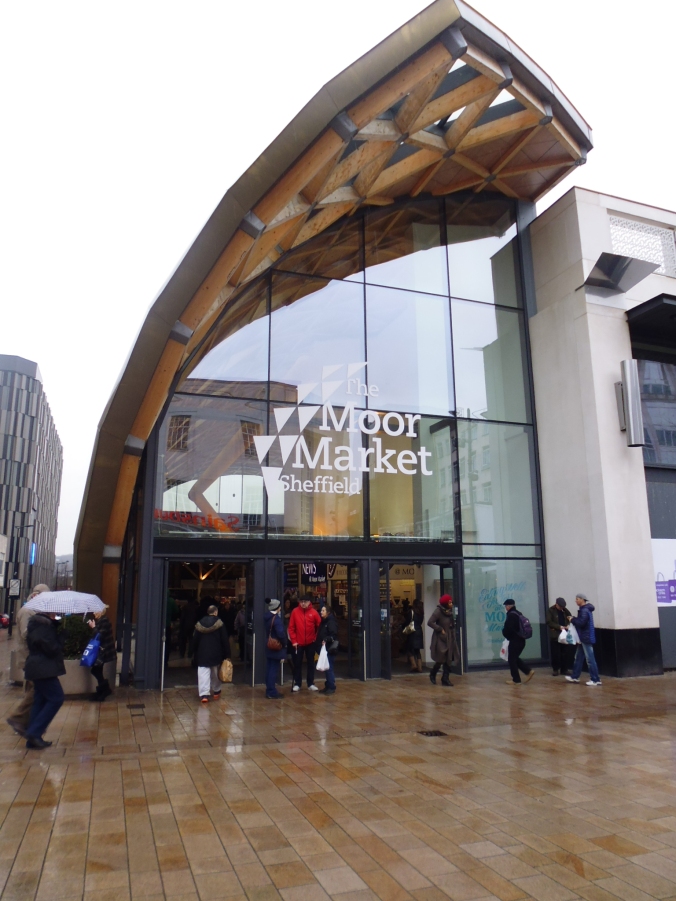Like most of the city, I haven’t made my mind about Sheffield’s new Moor Market which opened in November 2013 at a cost of £18 million. It replaced the old Castle Market, now being demolished, on the other side of town.
It hasn’t got its atmosphere for a start, a warren of ramshackle stalls on several floors with half-hidden alcoves, kiosks and offshots giving you the feeling it was a bazaar, with always something more to discover.
But in its last years Castle Market was dying on its feet as shopping habits changed in favour of clean, hygienic supermarkets and more affluent shoppers were put off by the druggies and undesirables lurking in the stairwells or roaming the balconies.
It was, however, in the traditional markets area of the city: the old Sheaf, Rag and Tag and Castlefolds Markets and Norfolk Market Hall (where Primark now is) occupied a large square bounded by the Haymarket and Exchange and Commercial Streets, with lively Dixon Lane running through the middle. It was also, as markets usually are, in the poorer part of the city centre. And that had been the case for at least 700 years until Sheffield City Council knew better.
The Moor Market has none of this history, nor the demographics or transport links. Castle Market was outside the bus stops running to the less affluent north of Sheffield from which it drew its customers. If you live in the north you are hardly likely to lug bags full of shopping back across town from The Moor to catch a bus.
As stallholder Mark Holmes, of Punch Stores, points out: “The 52 and 120 are the busiest bus routes in town but don’t come anywhere near us.” Is he any better off for the move from Castle? After all, the council made the first year either rent-free or half-rent. He now pays full rent, rates and service charges for the three units making up his bread and confectionery business and reckons he isn’t.
Footfall figures are disturbing. When the market first opened late in 2013, 400,000 flocked to see it in the first month, easily matching the city council’s prediction of 100,000 a week, and up by a third on Castle Market’s 300,000 a month. But by last November visitors had ‘flatlined’ at 57,000 a week, according to head of markets Andy Ward, as quoted in The Star. Mark’s hunch is that it is down to 50,000 and some will be there just to use the toilets or on a short cut. That means the council has spent £18 million on halving shoppers at the market.
Some traders think they have been sold a pup. What happened to the student accommodation which was to have been built above the market, providing a ready customer base?
Businesses have closed such as Smith’s, the handbag sellers who had traded for 163 years. Much newer ones, such as Seven Hills Bakery, are now open for just half the week. It doesn’t help that The Moor has become a less attractive place to visit with a building site for a new complex of shops, cinemas and restaurants across the way and Poundland’s old premises, check by jowl with the market entrance, still empty.
But not everyone is unhappy. The Castle Market was famous for its little tea stalls and cafes, few of which have survived. Of the 11 food kiosks in Moor Market, five are empty. At Sallies, run by Sallie and Andrew Steen, business is good. “We have never looked back from the move,” says Andrew.
Their old place where they sold all day breakfasts and liver sandwiches was in ‘Phase Five,’ off the beaten track in the Castle. They have a prime site – one turned down by the Seafayre chippie, now thriving in Charles Street. The couple had to promise not to serve all-day breakfasts because market officials didn’t want it to be a greasy spoon. However, the other things they wanted, fresh fruits, pasta and salads and a credit card machine (“used once a month,” says Andrew) have had almost nil demand. You still can’t get an all-day breakfast from them (try further along) but you can a hot roast pork Panini. And liver could be coming back!
The couple know their business, going since 1964, inside out. Sallie started washing dishes at the age of 11 at her aunt Edith’s stall at the old Norfolk Market Hall. “We treat every customer as if they are the only one,” adds Andrew.
Every city needs a bustling market and we must keep our fingers crossed for the Moor and hope the city council hasn’t shot itself in the foot again. Otherwise it will be as big a flop as the National Centre for Popular Music. And we all know the promises made for that.



I suspect part of the problem is aiming at the wrong demographic. Look at the crowds at ‘farmers markets’ such as Nether Edge, happy to pay realistic prices for premium products, or the crowded car park at Waitrose. The Castle Market customer trudging for a bus isn’t available in sufficient numbers, but aiming at them puts off the sort of customer who’d buy a premium product, but doesn’t expect to find it on the Moor. Opening in a recession is the other part, of course.
LikeLike
All of that is true but it is also a fact that there are quite a few stalls in the Moor Market selling excellent produce which wouldn’t be out of place in a farmers’ market and offer superior goods..
LikeLike
Agreed, but getting that message across seems to be proving difficult.
LikeLike